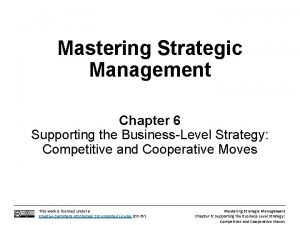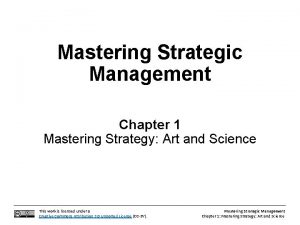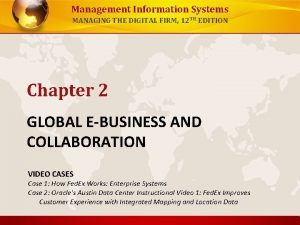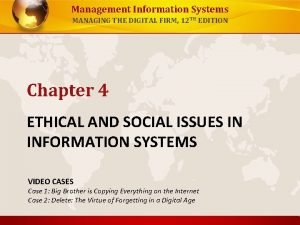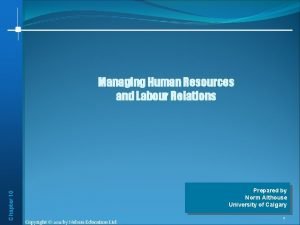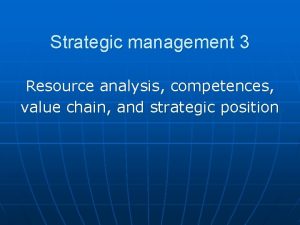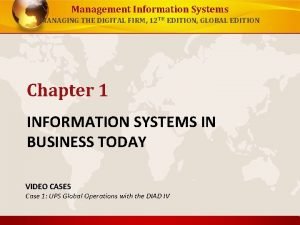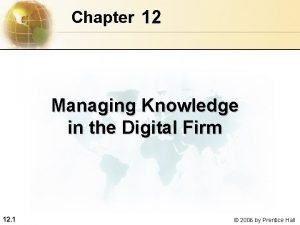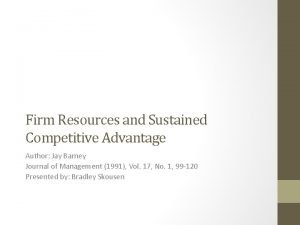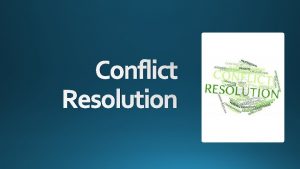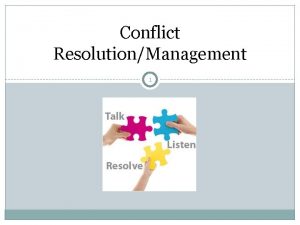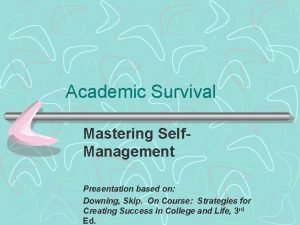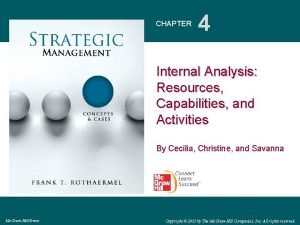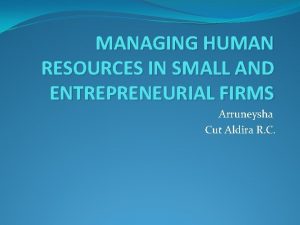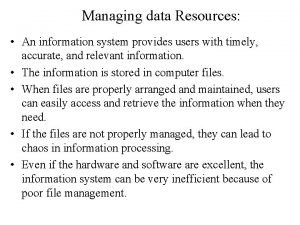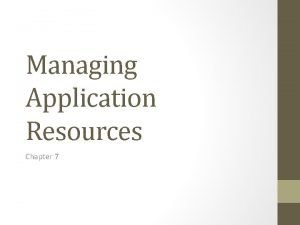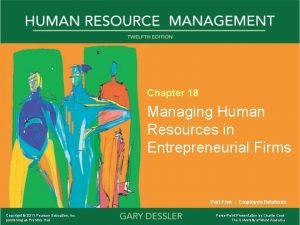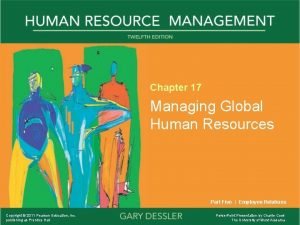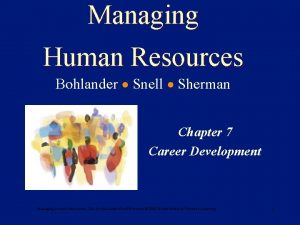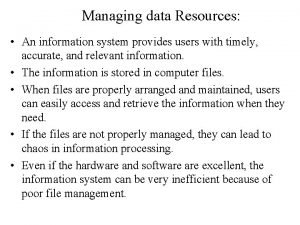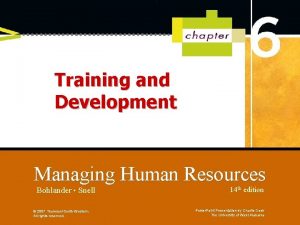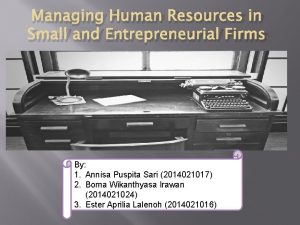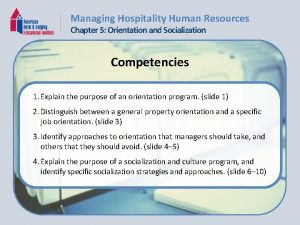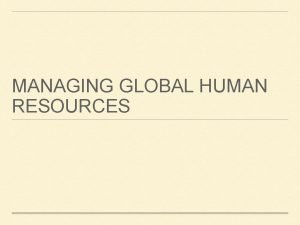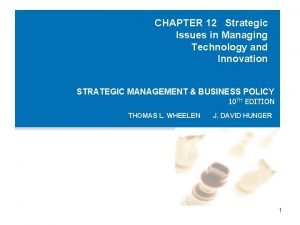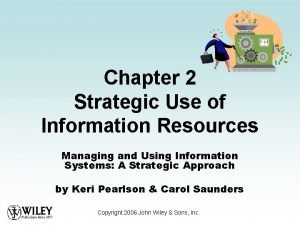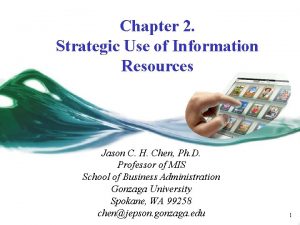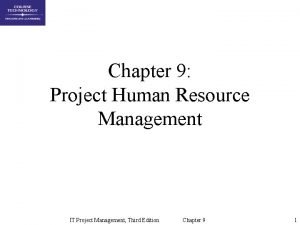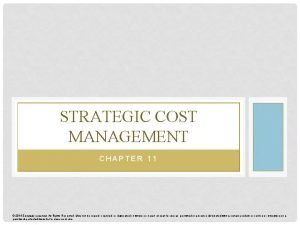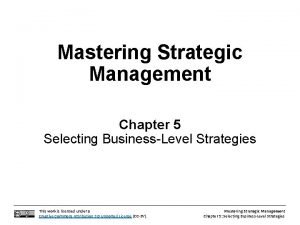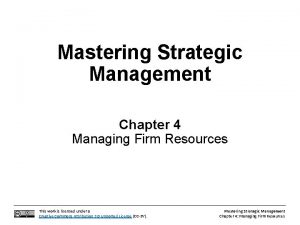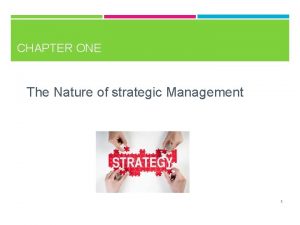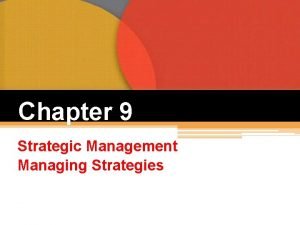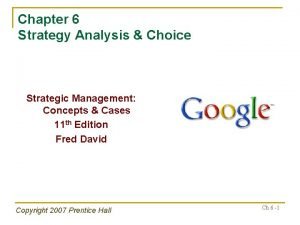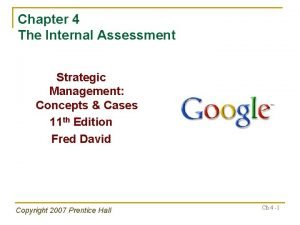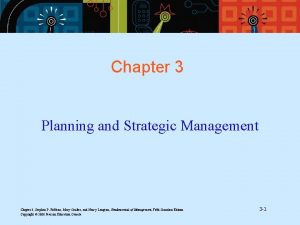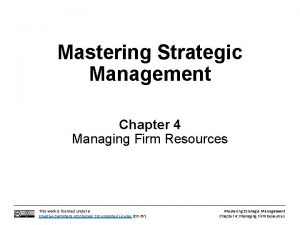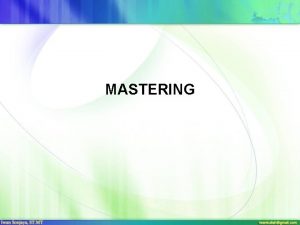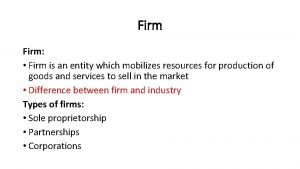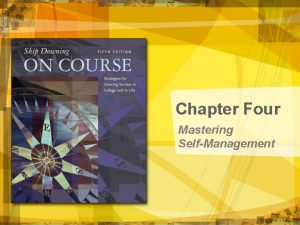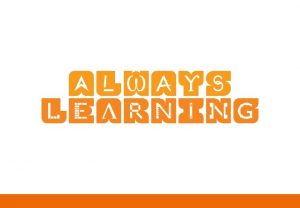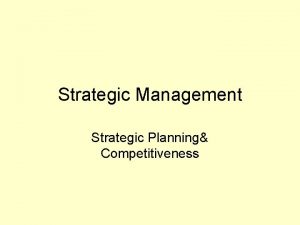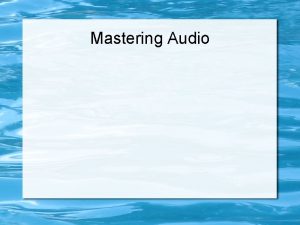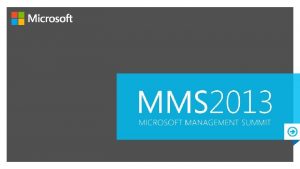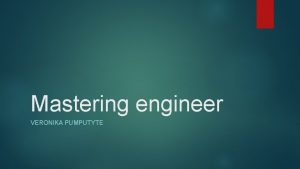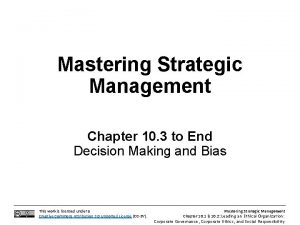Mastering Strategic Management Chapter 4 Managing Firm Resources

















































![SWOT - Harley Davidson Motorcycles What are the SWOT [Strengths, Weaknesses, Opportunities & Threats] SWOT - Harley Davidson Motorcycles What are the SWOT [Strengths, Weaknesses, Opportunities & Threats]](https://slidetodoc.com/presentation_image/3c1f823cf4fab3d609fd1ff25ab3146e/image-50.jpg)


- Slides: 52

Mastering Strategic Management Chapter 4 Managing Firm Resources This work is licensed under a Creative Commons Attribution 3. 0 Unported License (CC-BY). Mastering Strategic Management Chapter 4: Managing Firm Resources

Learning Objectives • Resource-based theory, the four characteristics of resources that can lead to sustained competitive advantage • Tangible & intangible resources & the Marketing Mix • Intellectual property, 4 principal types & its role as a value-added resource • Using the value chain to maximize org performance • Other theories of firms success and failure, & industry competition • SWOT analysis This work is licensed under a Creative Commons Attribution 3. 0 Unported License (CC-BY). Mastering Strategic Management Chapter 4: Managing Firm Resources

Can you get through my Maze? * What was your Strategy? This work is licensed under a Creative Commons Attribution 3. 0 Unported License (CC-BY). * Mastering Strategic Management Chapter 4: Managing Firm Resources

Resource-based Theory Possession of strategic resources provides an organization with a golden opportunity to develop competitive advantages over its rivals A strategic resource is: • Valuable • Rare • Difficult to imitate • Non-substitutable This work is licensed under a Creative Commons Attribution 3. 0 Unported License (CC-BY). Mastering Strategic Management Chapter 4: Managing Firm Resources

Resource-based Theory Sustained competitive advantage: A competitive advantage that will endure over time • Tangible resources: Resources than can be readily seen, touched, and quantified such as physical assets, property, plant, equipment and cash • Intangible resources: Resources that are difficult to see, touch, or quantify such as the knowledge and skills of employees, brand, firm’s reputation, & culture • Resources, where possible, protected by various legal means, including trademarks, patents, and copyrights This work is licensed under a Creative Commons Attribution 3. 0 Unported License (CC-BY). Mastering Strategic Management Chapter 4: Managing Firm Resources

Resource-based Theory • Capabilities: What an org can do based on the resources it possesses • Dynamic capability: Unique ability to create new capabilities by continually updating a firm’s array of capabilities in order to keep pace with changes in its environment • Distinctive competence: A set of activities that an organization performs especially well • Marketing mix: Consists of the four Ps (Product, Price, Place, Promotion) that firms use to offer customers a coherent and persuasive message This work is licensed under a Creative Commons Attribution 3. 0 Unported License (CC-BY). Mastering Strategic Management Chapter 4: Managing Firm Resources

This work is licensed under a Creative Commons Attribution 3. 0 Unported License (CC-BY). Mastering Strategic Management Chapter 4: Managing Firm Resources

8 Notice anything about these planes? This work is licensed under a Creative Commons Attribution 3. 0 Unported License (CC-BY). Mastering Strategic Management Chapter 4: Managing Firm Resources

Is the Resource Valuable? Organizational resources can be a source of competitive advantage only when they are valuable • Enable a firm to formulate and implement strategies that improve its efficiency or effectiveness • Resources are valuable when they are linked to the activities that are critically responsible to create what customers perceive as valuable This work is licensed under a Creative Commons Attribution 3. 0 Unported License (CC-BY). Mastering Strategic Management Chapter 4: Managing Firm Resources

Is the Resource Rare? Organizational resources also possessed by competitors are not sources of competitive advantage • Common strategies based on similar resources don’t provide any (one) firm an advantage • Competitive advantages are gained only from uncommon resources, resources that are rare to other competitors • Staff is often one unique resource! This work is licensed under a Creative Commons Attribution 3. 0 Unported License (CC-BY). Mastering Strategic Management Chapter 4: Managing Firm Resources

Can the Resource be Imitated? Difficulty in imitating resources is key to value creation because it constrains competition • Profits generated from difficult or un-imitable resources are much more sustainable • • Physical uniqueness Path dependency Causal ambiguity Social complexity This work is licensed under a Creative Commons Attribution 3. 0 Unported License (CC-BY). Mastering Strategic Management Chapter 4: Managing Firm Resources

Are Substitutes Readily Available? • There must be no strategically equivalent valuable resources that are themselves not rare or inimitable • Substitutability may take at least two forms • Competitor may be able to substitute a similar resource that enables it to develop and implement the same strategy • Very different firm resources can become strategic substitutes (such as e-business as a substitute for physical retail facility) This work is licensed under a Creative Commons Attribution 3. 0 Unported License (CC-BY). Mastering Strategic Management Chapter 4: Managing Firm Resources

This work is licensed under a Creative Commons Attribution 3. 0 Unported License (CC-BY). Mastering Strategic Management Chapter 4: Managing Firm Resources

Does your favorite restaurant have the 4 qualities of RBT? valuable, rare, difficult to imitate, & non-substitutable? This work is licensed under a Creative Commons Attribution 3. 0 Unported License (CC-BY). Mastering Strategic Management Chapter 4: Managing Firm Resources

Intangibles This work is licensed under a Creative Commons Attribution 3. 0 Unported License (CC-BY). Mastering Strategic Management Chapter 4: Managing Firm Resources

Southwest / West. Jet • Resource such as West. Jet’s culture that reflect all 4 qualities – valuable, rare, difficult to imitate & nonsubstitutable – are ideal because they can create sustained competitive advantage • Firms often bundle together multiple resources and strategies (that may not be unique in and of themselves) to create uniquely powerful combinations. • A resource or strategy that has 3 or less of the qualities can provide an edge in the short term, but competitors will overcome eventually This work is licensed under a Creative Commons Attribution 3. 0 Unported License (CC-BY). Mastering Strategic Management Chapter 4: Managing Firm Resources

Practice! For Apple, what strategic resources are: • Valuable • Rare • Difficult to imitate • Non-substitutable Apple - Not particularly innovative, secret is in customer experience and customer interfaces with product. Helps to have charismatic leader too! This work is licensed under a Creative Commons Attribution 3. 0 Unported License (CC-BY). Mastering Strategic Management Chapter 4: Managing Firm Resources

Practice! • Thinking about a local small airline, what tangible resources could they have? • Are these resources strategic? • Valuable, Rare, Difficult to imitate, Non-substitutable • What about their intangible resources? • Are these resources strategic? • Valuable, Rare, Difficult to imitate, Non-substitutable This work is licensed under a Creative Commons Attribution 3. 0 Unported License (CC-BY). Mastering Strategic Management Chapter 4: Managing Firm Resources

(Hopefully, you recall…) The 4 Ps of Marketing - Product This work is licensed under a Creative Commons Attribution 3. 0 Unported License (CC-BY). Mastering Strategic Management Chapter 4: Managing Firm Resources

4 Ps of Marketing - Price This work is licensed under a Creative Commons Attribution 3. 0 Unported License (CC-BY). Mastering Strategic Management Chapter 4: Managing Firm Resources

4 Ps of Marketing - Place This work is licensed under a Creative Commons Attribution 3. 0 Unported License (CC-BY). Mastering Strategic Management Chapter 4: Managing Firm Resources

4 Ps of Marketing - Promotion This work is licensed under a Creative Commons Attribution 3. 0 Unported License (CC-BY). Mastering Strategic Management Chapter 4: Managing Firm Resources

Practice! Thinking of B&B circus • What was their Marketing–Mix? • • Product Price Place Promotion This work is licensed under a Creative Commons Attribution 3. 0 Unported License (CC-BY). Mastering Strategic Management Chapter 4: Managing Firm Resources

Key Takeaways Resource Based Theory – strategic resources - valuable, rare, difficult to imitate, and non-substitutable can best position a firm for long-term success leading to superior performance over time. Capabilities are needed to bundle, to manage, and otherwise to exploit resources in a manner that provides value added to customers and creates advantages over competitors. This work is licensed under a Creative Commons Attribution 3. 0 Unported License (CC-BY). Mastering Strategic Management Chapter 4: Managing Firm Resources

4. 2 Intellectual Property (IP) Creations of the mind: inventions, artistic products, & symbols If IP is valuable, rare, & non-substitutable, can be strategic resource. Even if not all 4 criteria, can be strat res. when bundled with other resources/activities Variety of formal & informal methods protect firm’s IP: patents, trademarks, copyrights, & trade secrets Some forms of IP are best protected by legal means, while others are just kept secret West. Jet’s well-known culture, rivals free to copy Thus, culture not IP, although some complements - logo & unique color schemes - are! This work is licensed under a Creative Commons Attribution 3. 0 Unported License (CC-BY). Mastering Strategic Management Chapter 4: Managing Firm Resources

Intellectual Property - Patents Complex Process - Unique, non-obvious & useful This work is licensed under a Creative Commons Attribution 3. 0 Unported License (CC-BY). Mastering Strategic Management Chapter 4: Managing Firm Resources

This work is licensed under a Creative Commons Attribution 3. 0 Unported License (CC-BY). Mastering Strategic Management Chapter 4: Managing Firm Resources

Intellectual Property Copyright This work is licensed under a Creative Commons Attribution 3. 0 Unported License (CC-BY). Mastering Strategic Management Chapter 4: Managing Firm Resources

Intellectual Property This work is licensed under a Creative Commons Attribution 3. 0 Unported License (CC-BY). Mastering Strategic Management Chapter 4: Managing Firm Resources

This work is licensed under a Creative Commons Attribution 3. 0 Unported License (CC-BY). Mastering Strategic Management Chapter 4: Managing Firm Resources

Key Takeaways • Intellectual property can serve as a strategic resource for organizations • While some sources of intellectual property such as patents, trademarks, and copyrights can receive special legal protection, trade secrets provide competitive advantages by simply staying secret This work is licensed under a Creative Commons Attribution 3. 0 Unported License (CC-BY). Mastering Strategic Management Chapter 4: Managing Firm Resources

Practice! At your college or university, what strategic resources are: • Valuable • Rare • Difficult to imitate • Non-substitutable This work is licensed under a Creative Commons Attribution 3. 0 Unported License (CC-BY). Mastering Strategic Management Chapter 4: Managing Firm Resources

For teaching in two 90 minute classes/wk, possible break point This work is licensed under a Creative Commons Attribution 3. 0 Unported License (CC-BY). Mastering Strategic Management Chapter 4: Managing Firm Resources

Mega-Trends & RBT Thinking of the 4 strategic Resourced-Based Theory [Valuable - Rare - Difficult to imitate & - nonsubstitutable] • How would the types of innovations below, predicted to occur during your lifetime, affect strategies of firms? 1. 2. 3. 4. 5. 6. Climate Change Globalization - Cultures in Collision The Innovation Economy - Nano-Bio-IT-Neuro Longevity Medicine – more & more old people Protecting our future – loss of privacy Future Energy Pricing – some cheaper, some more $$ This work is licensed under a Creative Commons Attribution 3. 0 Unported License (CC-BY). Mastering Strategic Management Chapter 4: Managing Firm Resources

This work is licensed under a Creative Commons Attribution 3. 0 Unported License (CC-BY). Mastering Strategic Management Chapter 4: Managing Firm Resources

4. 3 The Value Chain Supply chain: System of people, activities, information, & resources involved in creating a product or service & moving it to the customer This work is licensed under a Creative Commons Attribution 3. 0 Unported License (CC-BY). Mastering Strategic Management Chapter 4: Managing Firm Resources

Value Chain – Primary Activities Actions that are directly involved in creation & distribution of good/service • Inbound logistics (arrival of new material) • Operations (production process) • Outbound logistics • Marketing and Sales (attracting potential customers) • Service (provide assistance to customers) This work is licensed under a Creative Commons Attribution 3. 0 Unported License (CC-BY). Mastering Strategic Management Chapter 4: Managing Firm Resources

Value Chain Secondary Activities Provide underlying support for • Primary activities, not directly involved in product itself • Firm infrastructure (how the firm is organized & led by executives) • HR Mgmt (recruitment, training, & compensation) • Technology (use of computers, IT systems & telecommunications to support primary activities) • Procurement (negotiating for & purchase of raw materials) This work is licensed under a Creative Commons Attribution 3. 0 Unported License (CC-BY). Mastering Strategic Management Chapter 4: Managing Firm Resources

Understanding (your) Value Creation Chain Focuses on the total value added to customer Four components of a strong value supply chain include: • Strategic supply chain management: Create comp. advantage by excelling along 4 measures: Speed, Quality, Cost, and Flexibility • Agility: Ability to respond rapidly to changes in supply or demand • Adaptability: Willingness & capacity to reshape supply chains when necessary • Alignment: Creating consistency in the interests of all participants in a supply chain This work is licensed under a Creative Commons Attribution 3. 0 Unported License (CC-BY). Mastering Strategic Management Chapter 4: Managing Firm Resources

Key Takeaways The value chain provides a useful tool for managers to examine systematically where value may be added to their organizations Useful by examining key elements in the production of a good or service, as well as areas in which value may be added in support of those primary activities. This work is licensed under a Creative Commons Attribution 3. 0 Unported License (CC-BY). Mastering Strategic Management Chapter 4: Managing Firm Resources

Discussion What are the advantages & disadvantages of Just-in-Time (JIT) delivery systems? For example, GM car assembly line’s JIT system only keeps 4 hours of tires in stock at any time This work is licensed under a Creative Commons Attribution 3. 0 Unported License (CC-BY). Mastering Strategic Management Chapter 4: Managing Firm Resources

4. 4 This work is licensed under a Creative Commons Attribution 3. 0 Unported License (CC-BY). Mastering Strategic Management Chapter 4: Managing Firm Resources

Other Theories of Firm Performance • Enactment: Contends that an organization can, at least in part, create an environment for itself that is beneficial by executing strategies that reshape competitive conditions in a favorable way or • Environmental determinism: Contends that organizations are very limited in their ability to adapt to the conditions around them, [laws & regulations, etc] This work is licensed under a Creative Commons Attribution 3. 0 Unported License (CC-BY). Mastering Strategic Management Chapter 4: Managing Firm Resources

Other Theories of Firm Performance • Institutional theory: Examines the extent to which firms copy each other’s strategies & choices *& how quickly they will too!) • Transaction cost economics: Focuses on the make/buy question – is it cheaper for a firm to make or to buy the products that it needs • Backward or Upstream integration strategy: Occurs when a firm enters the business of one of its suppliers This work is licensed under a Creative Commons Attribution 3. 0 Unported License (CC-BY). Mastering Strategic Management Chapter 4: Managing Firm Resources

Key Takeaways Although resource-based theory is the dominant perspective to predict performance in the strategic management field, other theories exist to explain firm behavior In some industries, explanations provided by these theories can be very convincing. This work is licensed under a Creative Commons Attribution 3. 0 Unported License (CC-BY). Mastering Strategic Management Chapter 4: Managing Firm Resources

4. 5 SWOT This work is licensed under a Creative Commons Attribution 3. 0 Unported License (CC-BY). Mastering Strategic Management Chapter 4: Managing Firm Resources

This work is licensed under a Creative Commons Attribution 3. 0 Unported License (CC-BY). Mastering Strategic Management Chapter 4: Managing Firm Resources

This work is licensed under a Creative Commons Attribution 3. 0 Unported License (CC-BY). Mastering Strategic Management Chapter 4: Managing Firm Resources

North Pole Inc. What are the SWOT Strengths & Weakness that might affect Santa over the next 3 to 5 years? What are the SWOT Opportunities & Threats that might affect Santa over the next 3 to 5 years? This work is licensed under a Creative Commons Attribution 3. 0 Unported License (CC-BY). Mastering Strategic Management Chapter 4: Managing Firm Resources
![SWOT Harley Davidson Motorcycles What are the SWOT Strengths Weaknesses Opportunities Threats SWOT - Harley Davidson Motorcycles What are the SWOT [Strengths, Weaknesses, Opportunities & Threats]](https://slidetodoc.com/presentation_image/3c1f823cf4fab3d609fd1ff25ab3146e/image-50.jpg)
SWOT - Harley Davidson Motorcycles What are the SWOT [Strengths, Weaknesses, Opportunities & Threats] that Harley-Davidson is facing over the next 3 to 5 years? This work is licensed under a Creative Commons Attribution 3. 0 Unported License (CC-BY). Mastering Strategic Management Chapter 4: Managing Firm Resources

Key Takeaways Executives using SWOT analysis compare internal strengths and weaknesses with external opportunities and threats to generate ideas about how their firm might become more successful. Ideas that allow a firm to leverage its strengths, steer clear of or resolve its weaknesses, capitalize on opportunities, and protect itself against threats are particularly helpful. This work is licensed under a Creative Commons Attribution 3. 0 Unported License (CC-BY). Mastering Strategic Management Chapter 4: Managing Firm Resources

In Conclusion, This chapter has explained key issues that executives face in managing resources and remaining competitive • Resource-based theory link firm performance with valuable, rare, difficult to imitate, & nonsubstitutable resources • Different forms of intellectual property – role(s) of patents, copyright, trademarks, & trade secrets • Value chain examines primary & secondary activities in creation of good/service, and linked to supply chain management • SWOT analysis is a simple but powerful technique for examining the interactions between factors internal and external to the firm This work is licensed under a Creative Commons Attribution 3. 0 Unported License (CC-BY). Mastering Strategic Management Chapter 4: Managing Firm Resources
 Strategic management chapter 6
Strategic management chapter 6 Mastering strategic management
Mastering strategic management Management information system managing the digital firm
Management information system managing the digital firm Management information systems managing the digital firm
Management information systems managing the digital firm Chapter 10 managing human resources
Chapter 10 managing human resources Resources and capabilities in strategic management
Resources and capabilities in strategic management Managing the digital firm
Managing the digital firm Managing knowledge in the digital firm
Managing knowledge in the digital firm Strategic management and strategic competitiveness
Strategic management and strategic competitiveness Tows matrix
Tows matrix Firm resources and sustained competitive advantage barney
Firm resources and sustained competitive advantage barney Watch mastering conflict management and resolution at work
Watch mastering conflict management and resolution at work Watch mastering conflict management and resolution at work
Watch mastering conflict management and resolution at work Mastering conflict management and resolution at work
Mastering conflict management and resolution at work Mastering self management
Mastering self management Dynamic strategic activity systems help a firm to maintain
Dynamic strategic activity systems help a firm to maintain Managing human resources in small and entrepreneurial firms
Managing human resources in small and entrepreneurial firms Managing data resources
Managing data resources Resources application
Resources application Employee selection
Employee selection Managing global human resources
Managing global human resources Important of human resource
Important of human resource Managing human resources snell
Managing human resources snell Managing data resources
Managing data resources Information technology resource
Information technology resource Bohlander and snell
Bohlander and snell Managing human resources in small and entrepreneurial firms
Managing human resources in small and entrepreneurial firms Managing hospitality human resources
Managing hospitality human resources Managing global human resources
Managing global human resources Eddy current
Eddy current Mastering biology chapter 24
Mastering biology chapter 24 Strategic issues in managing technology and innovation
Strategic issues in managing technology and innovation The transformation process
The transformation process Example of fixed resources
Example of fixed resources Renewable resources vs nonrenewable resources
Renewable resources vs nonrenewable resources Strategic use of information resources
Strategic use of information resources Strategic use of information resources
Strategic use of information resources Strategic fit vs strategic intent
Strategic fit vs strategic intent Strategic substitutes and complements
Strategic substitutes and complements Chapter 9 human resource management
Chapter 9 human resource management Human resource management chapter 1
Human resource management chapter 1 Chapter 9 human resources management
Chapter 9 human resources management Chapter 11 strategic cost management
Chapter 11 strategic cost management Strategic management chapter 5
Strategic management chapter 5 Strategic management chapter 4
Strategic management chapter 4 Nature of strategic management
Nature of strategic management Chapter 9 strategic management
Chapter 9 strategic management Strategic management chapter 7
Strategic management chapter 7 Management issues central to strategy implementation
Management issues central to strategy implementation Implementing strategies: management and operations issues
Implementing strategies: management and operations issues What are the two external dimensions of the space matrix?
What are the two external dimensions of the space matrix? Chapter 4 strategic management
Chapter 4 strategic management Chapter 3 planning organization and management
Chapter 3 planning organization and management
